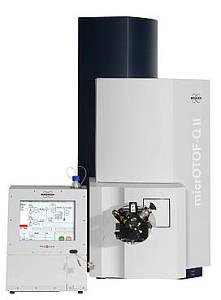|
Instrument Database:
Bruker Daltonics - micrOTOF-Q II - ESI-Qq-TOF mass spectrometer
| |
|

|
| |
|
| |
|
| Year of introduction |
2008 |
| Status |
historical ( out of sale ) |
| Company |
Bruker Daltonics
|
| Categories |
Hyphenated Techniques: LC-MS
Mass spectrometer: ESI-MS
Mass spectrometer: LC-MS
|
|
Have maximum confidence in your analytical system. The new micrOTOF-Q II™ ESI-Qq-TOF mass spectrometer features the very latest technology developments to provide maximum certainty in your research in Small Molecule Identification, Metabolomics and Proteomics. Easy formula determination of small molecules, metabolic studies, analysis of complex mixtures, digests and in-depth evaluation of intact proteins are key applications. MS/MS performance
Bringing together the unprecedented features of micrOTOF - the excellent mass accuracy on fragments and superb focus resolving power exceeding 17,500 FWHM - with flexible data dependant MS/MS strategies, the micrOTOF-Q II allows de novo sequencing of peptides even for post-translational modifications. Confident results in proteomics research meets accurate mass and structural analysis of small molecules.
The formula machine
The combination of mass accuracy 1-2 ppm, high resolution >17.500 FWHM and True Isotopic Pattern (TIP) makes the micrOTOF-Q II the real formula machine. TIP is applied to precursor and fragment ions which is an outstanding features in formula generation by MS.
Protein identification and quantification
The micrOTOF-Q ESI-Qq-TOF mass spectrometer is an ideal instrument for the determination of protein regulation in proteomic research. Standard labels are applicable with high reliability and reproducibility due to the high mass accuracy and resolution of the instrument over the entire mass range. Excellent sensitivity is provided by the unique ESI ion funnel technology. A sophisticated software solution, WARP-LC, comprehensively supports stable isotope labeled experiments (SILE).
Metabolite ID
Metabolite and small molecule prediction and detection is performed by MetaboliteTools™, allowing detailed evaluation of samples and sample batches based on the sophisticated eXpose™ detection algorithm and accurate mass capabilities of micrOTOF-Q II. MetaboliteTools predicts possible metabolites from a given drug structure, and extracts relevant information on existing metabolites for LC-MS data.
|
| Specifications |
|
|
Cutting-edge performance
- Advanced micrOTOF-Q II technology
- World-leading combination of mass accuracy, resolution and sensitivity without compromise
- SmartFormula 3DTM, the novel combination of accurate mass of parent and fragment ions with True Isotopic Pattern (TIP™)
- Wide dynamic range for ultra-stable accurate mass
- High-performance Q-q-front end
- Dimensions 640 x 949 x 1320 mm, weight 160 kg
Source options
- Apollo II ion funnel ESI Electrospray source
- APCI atmospheric pressure chemical ionization source
- ESI/APCI multimode source
- APPI atmospheric pressure photo ionization source
- Online / offline NanoElectrospray source
- CE/MS coupling with grounded ESI needle
Analytical performance
- Mass range 50 – 20,000 m/z
- Mass accuracy 1 - 2 ppm RMS Error (internal), 5 ppm RMS Error (external)
- Mass resolution 17,500 (FWHM), typically 20,000 FWHM at LC-speed
- Temperature compensated
- Acquisition rate (2GHz sampling rate) 20 Hz
- (profile and peak detected spectra to disk)
Compass & application software suites
- Integrated LC-MS/MS control and data processing
- SmartFormula and novel SmartFormula 3D
- BioTools™ / RapiDeNovo™ software for protein data interpretation
- MetaboliteTools™ for metabolite identification
- ProteinScape™ database system for proteome project management
- TargetAnalysis™ – for multi-target compound screening
- Compass OpenAccessTM: Walk-up LC/MS chemical formula generation
The micrOTOF-Q II seamlessly integrates into Bruker Daltonics’ system solutions:
- Metabolic Profiler™: The unique NMR-MS solution for Metabolomic Studies
- PROTEINEER™: 2D Gel-MS/MS-based proteomics suite
- ProteomeQuant™: LC-MS/MS-based proteomics suite
- LC-NMR/micrOTOF-Q II coupling.
|
Related links:
|